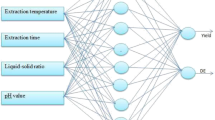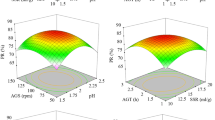Abstract
This study combines artificial neural network (ANN) with a novel metaheuristic technique, satin bowerbird optimizer (SBO) for predicting oil, and pectin yield from watermelon rind. The experimental design was based on two-level factors, drying temperature (°C) and heating time (hours) for oil yield (%) and three-level factors, drying temperature (°C), extraction time (min), and pH for pectin yield (%) using response surface methodology (RSM). The RSM and SBO optimization resulted oil yield of 17.7–26.6% at conditions of drying temperature (90–100°C), and heating time (8.7–9 h), while pectin yield is between 21 and 37.6% at extraction temperature (80–100), extraction time (46.3–60 min), and pH (1–3). However, ANN predicted more accurately than the RSM model, with a lower percentage relative error. It was observed that pH and extraction time are pertinent process parameters for predicting pectin yield. Similarly, drying temperature is significant for oil extraction from watermelon.
Graphical abstract










Similar content being viewed by others
Availability of Data and Material
All data generated or analyzed during this study are included in this article and its additional files. The experimental values of response surface methodology (RSM) design as well as the artificial neural networks (ANN) data used are contained in an Excel File. Requests for material should be made to the corresponding author.
Abbreviations
- W:
-
weight of sample (g)
- P:
-
amount of dry pectin (g)
- RSM:
-
response surface optimization
- ANN:
-
artificial neural network
- SBO:
-
satin bower optimizer
- SBBOA:
-
satin bower bird optimization algorithm
- RMSE:
-
root mean square error
- MAPE:
-
mean absolute percent error
- MSE:
-
mean square error
- CCRD:
-
central composite rotatable design
- 2FI:
-
two factorial interaction
- k :
-
number of independent variables
- h :
-
layer
- out :
-
output
- i :
-
initial
- 1 :
-
empty flask
- 2 :
-
flask and extracted oil
- n:
-
number of repetition of experiments
- V:
-
vector network input
References
Adepoju TF, Esu IO, Olu-Arotiowa OA, Blessed E (2019) Oil extraction from butter fruit (Dacryodes edulis) seeds and its optimization via response surface and artificial neural network. Nigerian J Technol Dev 16(2):56. https://doi.org/10.4314/njtd.v16i2.2
Agu CM, Menkiti MC, Ekwe EB, Agulanna AC (2020) Modeling and optimization of Terminalia catappa L. kernel oil extraction using response surface methodology and artificial neural network. Artif Intell Agric 4:1–11. https://doi.org/10.1016/j.aiia.2020.01.001
Aravantinos-Zafiris GVO (1991) The effect of nitric acid extraction variables on orange pectin. J Sci Food Agric 60:127–129
Babu BV (2004) Process plant simulation. Oxford University Press, New Delhi, India, p 257e290
Betiku E, Ajala SO (2014) Modeling and optimization of Thevetia peruviana (yellow oleander) oil biodiesel synthesis via Musa paradisiacal (plantain) peels as heterogeneous base catalyst: a case of artificial neural network vs. response surface methodology. Ind Crop Prod 53:314–322
Betiku E, Okunsolawo SS, Ajala SO, Odedele OS (2015) Performance evaluation of artificial neural network coupled with generic algorithm and response surface methodology in modeling and optimization of biodiesel production process parameters from shea tree (Vitellaria paradoxa) nut butter. Renew Energy. Elsevier Ltd. https://doi.org/10.1016/j.renene.2014.11.049
Chan SY, Choo WS, Young DJ, Loh XJ (2017) Pectin as a rheology modifier: origin, structure, commercial production and rheology. Carbohydr Polym 161:118–139
Charles AL, Sriroth K, Huang TC (2005) Proximate composition, mineral contents, hydrogen cyanide and phytic acid of 5 cassava genotypes. Food Chem 92:615–620
Chen W, Chen X, Peng J, Panahi M, Lee S (2021) Landslide susceptibility modeling based on ANFIS with teaching-learning-based optimization and Satin bowerbird optimizer. Geosci Front 12(1):93–107. https://doi.org/10.1016/j.gsf.2020.07.012
El-Hay EA, El-Hameed MA, El-Fergany AA (2018) Steady-state and dynamic models of solid oxide fuel cells based on satin bowerbird optimizer. Int J Hydrog Energy 43(31):14751–14761
Esonye C, Onukwuli OD, Anadebe VC, Ezeugo JNO, Ogbodo NJ (2021) Application of soft-computing techniques for statistical modeling and optimization of Dyacrodes edulis seed oil extraction using polar and non-polar solvents. Heliyon 7(3):e06342. https://doi.org/10.1016/j.heliyon.2021.e06342
Fakayode OA, Abobi KE (2018) Optimization of oil and pectin extraction from orange (Citrus sinensis) peels: a response surface approach. J Anal Sci Technol 9(1):1–16. https://doi.org/10.1186/s40543-018-0151-3
Gama B, De-Farias-Silva CE, Oliveira-Da-Silva LM, Abud AKS (2015) Extraction and characterization of pectin from citric waste. Chem Eng Trans 44:259–264
Garg A, Jain S (2020) Process parameter optimization of biodiesel production from algal oil by response surface methodology and artificial neural networks. Fuel 277:118254. https://doi.org/10.1016/j.fuel.2020.118254
Hartati I, Riwayati I, Subekti E (2014) Microwave assisted extraction of watermelon rind pectin with different kind of acid solution. ICETIA 8(11):27–30
Jagadeeswar RC, Saripiralla B, Geetha V (2021) Satin bowerbird optimization algorithm for the application of optimal power flow of power system with FACTS devices. Turk J Comp Math Educ (TurcomatOrg) 12(11):1641–1659 Retrieved from https://turcomat.org/index.php/turkbilmat/article/view/6099. Accessed 22 Oct 2021
Jiang LN, Shang JJ, He LB, Dan JM (2012) Comparisons of microwave-assisted and conventional heating extraction of pectin from seed watermelon peel. Adv Mater Res 550–553:1801–1806. https://doi.org/10.4028/www.scientific.net/AMR.550-553.1801
Kant G, Sangwan KS (2015) Predictive modelling and optimization of machining parameters to minimize surface roughness using artificial neural network coupled with genetic algorithm. Proc CIRP 31:453–458. https://doi.org/10.1016/j.procir.2015.03.043
Kant G, Rao VV, Sangwan KS (2013) Predictive modeling of turning operations using response surface methodology. Appl Mech Mater 307:170
Khan M, Bibi N, Zeb A (2015) Optimization of process conditions for pectin extraction from citrus peel. Sci Technol Dev 34(1):9–15
Leong LP, Shui G (2002) An investigation of antioxidant capacity of fruits in Singapore markets. Food Chem 76:69–75
Maran JP, Priya B (2015) Ultrasound-assisted extraction of pectin from sisal waste. Carbohydr Polym 115:732–738. https://doi.org/10.1016/j.carbpol.2014.07.058
Mellinas C, Ramos M, Jiménez A, Garrigós MC (2020) Recent trends in the use of pectin from agro-waste residues as a natural-based biopolymer for food packaging applications. Mater MDPI AG. https://doi.org/10.3390/ma13030673
Noreen A, Nazli Z-H, Akram J, Rasul I, Mansha A, Yaqoob N, Iqbal R, Tabasum S, Zuber M, Zia KM (2017) Pectins functionalized biomaterials; a new viable approach for biomedical applications: a review. Int J Biol Macromol 101:254–272
Olatunji OM, Charles K, Ekanem JT, Horsfall IT, Okon SK (2021a) Oil and pectin extraction from citrus paradise (grape) peels: a case of response surface optimization. MOJ Food Process Technol 9(2):44–55
Olatunji OM, Horsfall IT, Ubom EV (2021b) Response surface optimization approach to predict the maximum %biodiesel yield via transesterification of esterified shea butter oil by utilizing bio-catalysts. Curr Res Green Sustain Chem 4:100167. https://doi.org/10.1016/j.crgsc.2021.100167
Onoji SE, Iyuke SE, Igbafe AI, Daramola MO (2019) Hevea brasiliensis (rubber seed) oil: modeling and optimization of extraction process parameters using response surface methodology and artificial neural network techniques. Biofuels 10(6):677–691. https://doi.org/10.1080/17597269.2017.1338122
Perez J, Gomez K, Vega L (2021) Optimization and physicochemical characterization of pectin extraction from watermelon rind. Res Square. https://doi.org/10.21203/rs.3.rs-268492/v1
Petkowicz CLO, Vriesmann LC, Williams PA (2017) Pectins from food waste: extraction, characterization and properties of watermelon rind pectin. Food Hydrocoll 65:57–67. https://doi.org/10.1016/j.foodhyd.2016.10.040
Reddy CJ, Basamma S, Geetha V (2021) Satin bowerbird optimization algorithm for the application of optimal power flow of power system with FACTS devices. Turk J Comp Math Educ 12(11):1641–1659
Samareh MSH, Bardsiri VK (2017) Satin bowerbird optimizer: a new optimization algorithm to optimize ANFIS for software development effort estimation. Eng Appl Artif Intell 60:1–15
Sangwan KS, Kant G, Deshpande A, Sharma P (2013) Modeling of stresses and temperature in turning using finite element method. Appl Mech Mater 307:174
Sodeke VA (2005) Extraction of oil from watermelon seed. Anal Q Res Serv 2005:25–30
Tanarslan HM, Secer M, & Kumanlioglu A (2012) An approach for estimating the capacity of RC beams strengthened in shear with FRP reinforcements using artificial neural networks. Construct Build Mater 30, 556–568
Temitayo OD (2017) Optimization of oil extraction from Thevetia peruviana (yellow oleander) seeds: a case study of two statistical models. Int J Eng Modern Technol 3(4):2504–8856 Retrieved from www.iiardpub.org. Accessed 4 Nov 2021
Uzoh FC, Onukwuli DO (2016) Extraction, analysis and desaturation of gmelina seed oil using different soft computing approaches. S Afr J Chem Eng 22:6–16. https://doi.org/10.1016/j.sajce.2016.07.001
Author information
Authors and Affiliations
Corresponding author
Ethics declarations
Conflict of Interest
The authors declare no competing interests.
Additional information
Publisher’s Note
Springer Nature remains neutral with regard to jurisdictional claims in published maps and institutional affiliations.
Rights and permissions
About this article
Cite this article
Olatunji, O.M., Itam, D.H., Akpan, G.E. et al. Predictive Modeling Coupled with Multiple Optimization Techniques for Assessing the Effect of Various Process Parameters on Oil and Pectin Extraction from Watermelon Rind. Process Integr Optim Sustain 6, 765–779 (2022). https://doi.org/10.1007/s41660-022-00248-0
Received:
Revised:
Accepted:
Published:
Issue Date:
DOI: https://doi.org/10.1007/s41660-022-00248-0




